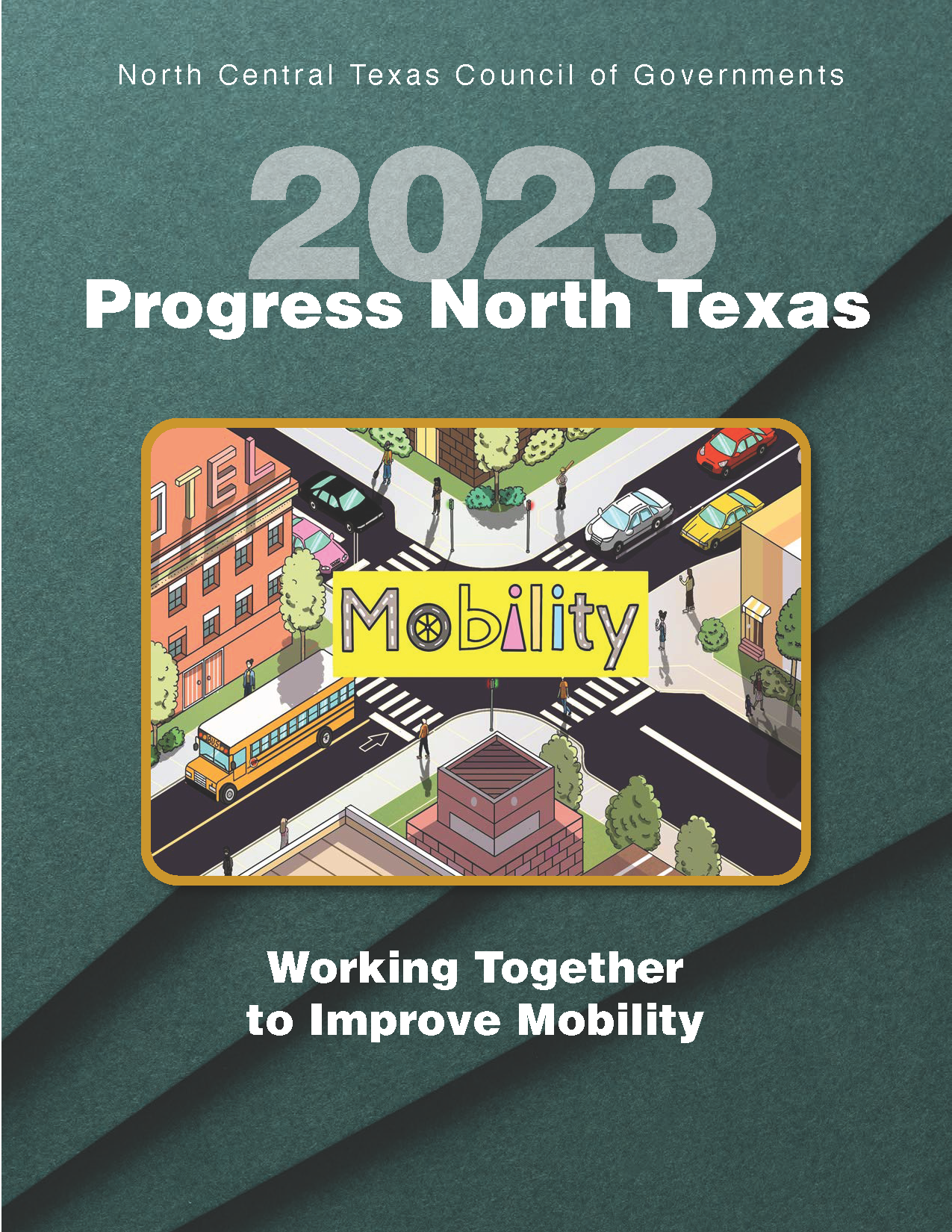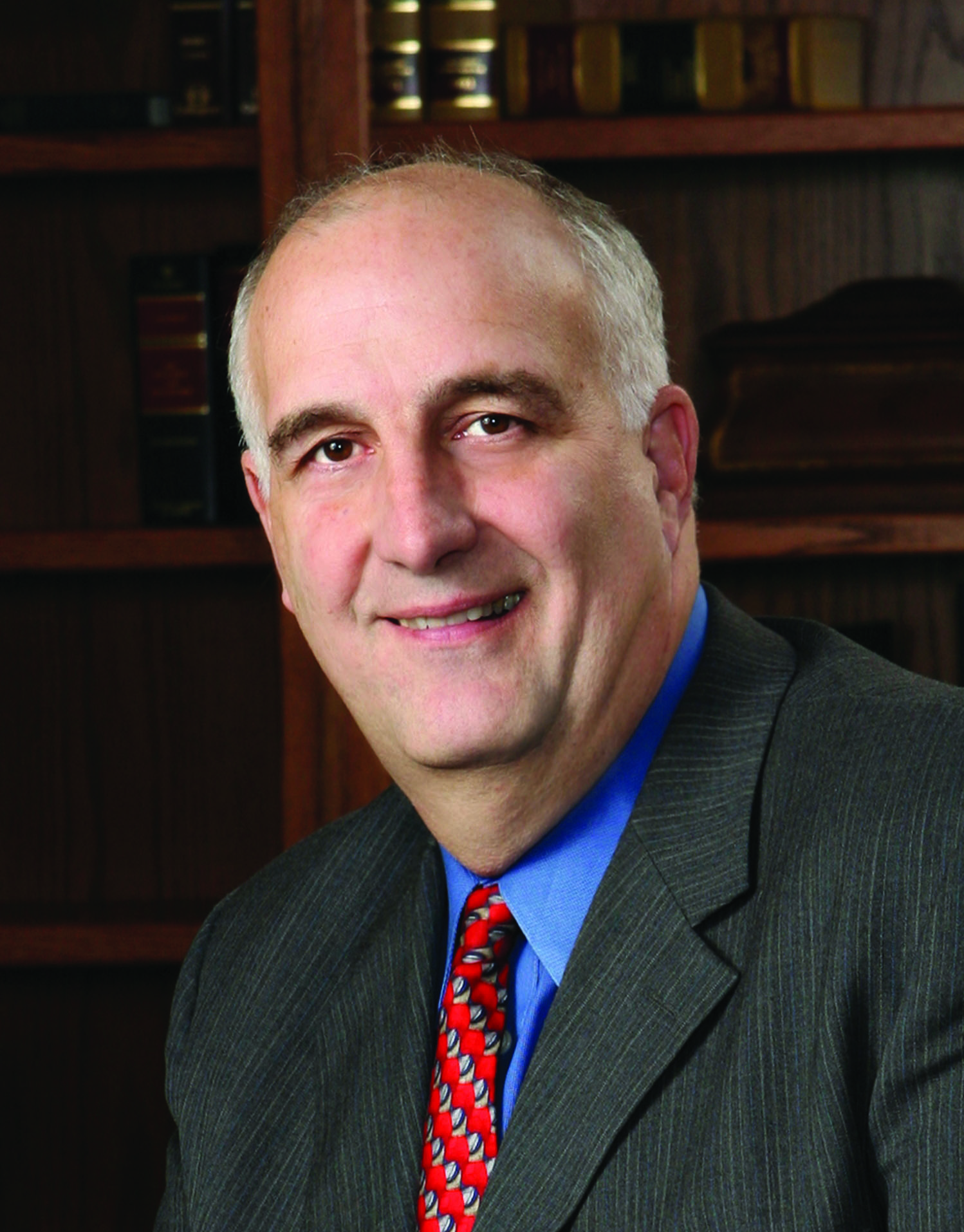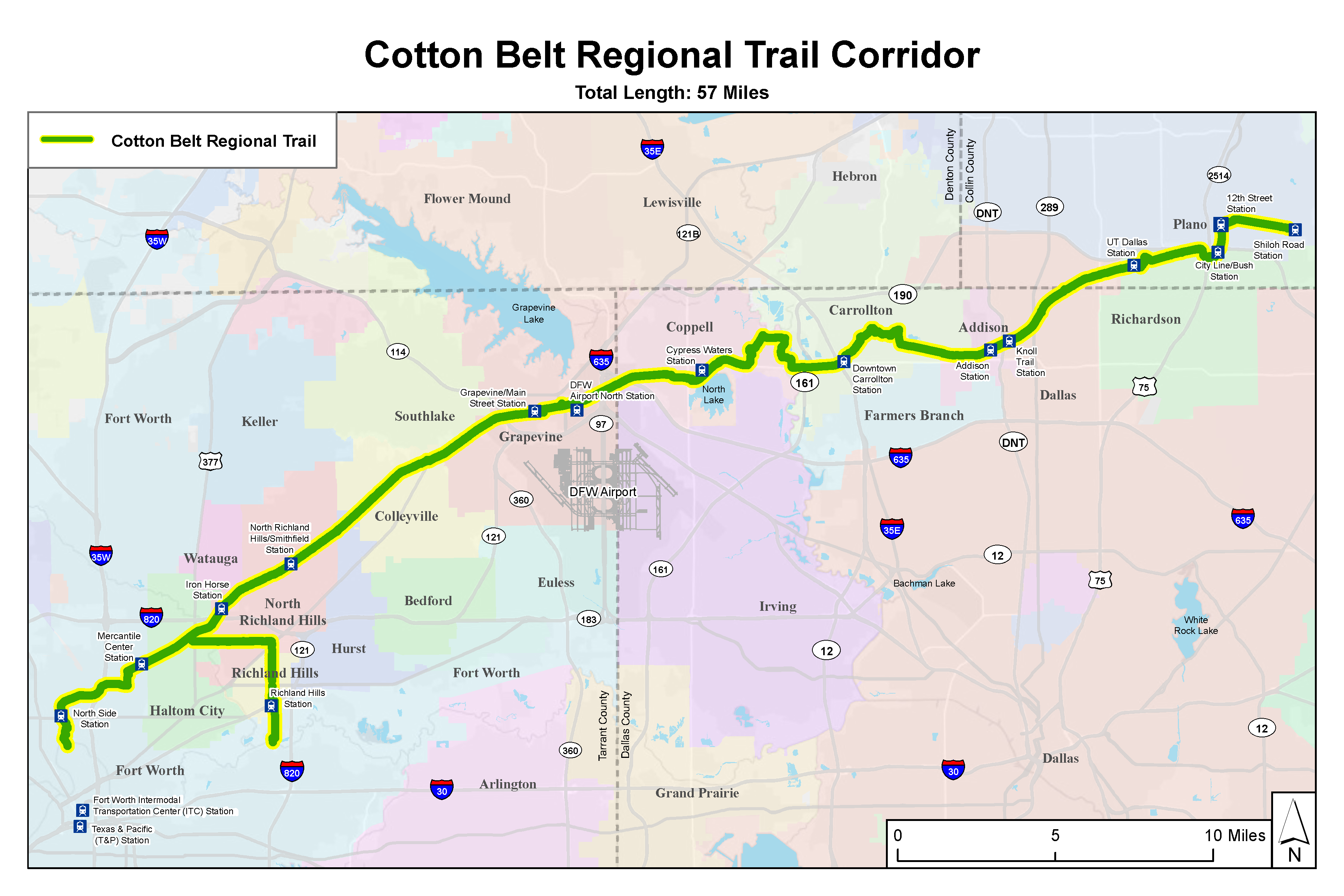Progress North Texas 2023
 Contents:
Contents:
- Message from the Chair
- North Texas Today
- Roadways
- Transit
- Bicycle-Pedestrian
- Safety
- Aviation
- Freight
- Technology
- Air Quality
- Public Involvement
- 2023 Art Contest Winner
Message from the Chair
 Thank you for reading Progress North Texas 2023. As chair of the Regional Transportation Council, I find the publication of this annual state of the region report refreshing because it focuses on what has been accomplished and how the region’s transportation partners cooperate to build projects and plan for future endeavors. This year’s theme is Working Together to Improve Mobility.
Thank you for reading Progress North Texas 2023. As chair of the Regional Transportation Council, I find the publication of this annual state of the region report refreshing because it focuses on what has been accomplished and how the region’s transportation partners cooperate to build projects and plan for future endeavors. This year’s theme is Working Together to Improve Mobility.
The RTC collaborates with our local, state and federal partners to deliver improvements to the transportation system that will keep Collin County and the region moving.
As we continue to see transportation numbers return to pre-pandemic figures, we must assess all aspects of the transportation system to ensure it is adequately improving to meet the needs of commuters. No matter if you walk, bike, drive, or take public transportation to your destination, improving your travel experience is the responsibility of many agencies.
In this report, you will read about the progress made and work that remains in areas such as regional air quality, surface and air transportation, and innovative technologies that could make the system more reliable for the 8 million residents who call the area home.
I would like to thank Enqi Wang from Plano East Senior High School for contributing to this year’s cover art. As a longtime resident of Collin County and former Plano ISD school board member, I am blown away by the talent of our young people. It assures me that the future of the place I call home is in great hands.
Gaining perspective from those who use the system daily will help us ensure the right decisions are made. I encourage you to read and analyze this report. Then, tell us what you think. As we continue to improve the transportation infrastructure, public participation is integral to the planning process and a knowledgeable public is one of the greatest tools we have. Thank you for reading. We look forward to hearing from you in the future.
Sincerely,
Duncan Webb
Chair, Regional Transportation Council
Commissioner, Collin County
return to top
North Texas Today

Dallas-Fort Worth has a population of over 8 million people and a workforce of nearly 6 million.
The Dallas-Fort Worth area continues to attract new residents faster than many other regions of the country. The 12-county metropolitan planning area has a population of 8 million. More people live in North Texas than in 38 individual US states. Employment in the 9,448-square-mile metropolitan area stands at 5.7 million and is growing. By 2045, the population is expected to surpass 11 million, and the workforce is forecast to be 8 million strong. This kind of growth requires close attention to be paid to the transportation system, as planners and policymakers work together to keep people moving. The North Central Texas Council of Governments coordinates with its partners on projects to increase roadway capacity, while also maintaining the existing infrastructure to ensure the vehicles on the roadways can move safely and reliably.
Congestion
Two companies collecting traffic data paint a positive picture of how the region is dealing with its increasing population. TomTom placed the region No. 33 in the country in its index of traffic congestion, based on the amount of time it takes to travel 10 kilometers. Although there was a slight decline in reliability compared to 2021, the change was only a few seconds. Seattle, by contrast, saw an increase in this metric of nearly a minute, despite its smaller population.
INRIX, another company that collects and integrates traffic data in the US, indicated that the average Dallas-Fort Worth driver spends 56 hours a year in traffic. This puts the region No. 14 in the country. When considering population, Dallas-Fort Worth drivers fare better than their counterparts in many metro areas, including Atlanta, Houston, Philadelphia, and Miami.
Traffic Counts
Data at the region's permanent reporting stations shows that traffic continued its rebound from the pandemic in 2022. For most of the year, traffic volumes were slightly below the pre-pandemic levels. By the fall and early winter, volumes were consistently 1-2% above the pre-pandemic baseline. Speeds also showed a return to pre-pandemic levels in 2022.
Reliability
Reliability refers to the predictability and consistency of congestion and travel times. Reliability can be negatively impacted by weather, crashes, special events, roadway geometry and other unpredictable factors. It can be improved by asset optimization, ITS infrastructure, safety patrols and provision of alternate routes. Reliable commutes are easier to plan for and lessen the economic impact of congestion. In 2021, 78.9% of travel on interstates and 86.1% of travel on non-interstate major roadways in the region met federal thresholds for reliability. These figures were also within regional targets. Additionally, the average traveler spent 11.4 hours in excessive delay conditions in 2021, down from roughly 14 hours before the pandemic and significantly below the regional target. For more information on federal performance measures, visit www.nctcog.org/pm/fed.
Managed Lanes Data
Monthly transactions on the region’s toll roads and managed lanes showed consistent growth for most of the year. For example, transactions on the Interstate Highway 35E TEXpress managed lanes were up starting in March and were 10% above the baseline in December. Transactions on these managed lanes were higher than before the pandemic for the first time, further demonstrating a return of traffic. Data from the North Texas Tollway Authority paints a similar picture, with transactions higher than the pre-pandemic baseline much of the year. With the roadway system returning to its historical norms in 2022, a combination of investment and collaboration among agencies will help North Texas continue to meet the needs of residents and businesses.
return to top
Roadways
To accommodate the growth of Dallas-Fort Worth, an efficient roadway system is needed, whether the destination is close or another part of the state or nation. The North Central Texas Council of Governments works with transportation partners at all levels of government to maintain the current system and expand it where necessary.
Pavement and Bridge conditions
Sometimes, the partnerships are nontraditional, as is the case with the effort to improve bridges. NCTCOG is collaborating with the University of Texas at Arlington through the University Partnership Program to develop and identify optimized bridge treatments to improve bridge conditions and help them last longer.
There are multiple opportunities through the Bipartisan Infrastructure Law for which NCTCOG is working with partners to obtain new funding for critical projects. Additionally, NCTCOG and local governments are coordinating to address National Highway System (NHS) arterial streets not part of TxDOT’s on-system roadways, to ensure they are similarly improved.
Federal Performance Measures
NCTCOG monitors the condition of pavement and bridges along the region’s 12,000 lane-miles of NHS interstate and non-interstate roadways as part of its federal performance measure activities. These activities include either the adoption of unique regional pavement and bridge condition targets or a decision to affirm and support statewide targets for these measures. In summer 2023, the RTC will vote to either affirm TxDOT’s newly adopted statewide pavement and bridge condition targets or establish its own regional targets. Policymakers continue to track and report the condition of the region's pavement and bridges as data is available. For more on the federal performance measures being collected, visit www.nctcog.org/pm/fed.
Major Transportation Investments
Major infrastructure improvements in Dallas-Fort Worth moved forward in 2022, with approximately $2.8 billion in transportation projects going to construction. In Kaufman County, a project on US Highway 80 from Lawson Road to FM 460 will result in the widening of the highway’s main lanes and frontage roads. The project is expected to provide congestion relief for those traveling between Dallas County and Kaufman County. In the western part of the region, work began on the Southeast Connector project in southeast Tarrant County. This 16-mile-long project along IH 20, US 287 and IH 820 will provide numerous benefits, including enhancements to safety, trade and overall efficiency. The project will include freeway, interchange and frontage road improvements, as well as enhanced bicycle and pedestrian facilities.
The Regional Transportation Council continued to fund projects across all modes in 2022, including $167 million of total funding for an extension of Trinity Metro's TEXRail commuter line from the Fort Worth Central Station to the Fort Worth Medical District. Additionally, the RTC programmed $882 million to major infrastructure projects in the region during TxDOT’s Unified Transportation Program process.
Projected Revenue Sources through 2045
| Revenue Source | Amount* | Share |
|---|---|---|
| Traditional Federal and State | $45.9 | 31% |
| Traditional Transit | $43.7 | 29% |
| Innovative Transit | $23.1 | 16% |
| Local | $20.8 | 14% |
| Toll System and Innovative | $7.9 | 5% |
| Revenue Enhancements | $6.8 | 5% |
Congestion Management Process
Although major capital investments are needed to meet the growing travel demand, the Congestion Management Process develops lower-cost strategies that complement major capital recommendations. The result is a more efficient and effective transportation system, increased mobility, safer travel and reduced vehicle emissions to improve air quality. For more information, visit www.nctcog.org/cmp.
Mobility 245
2022 was productive for transportation planning in North Texas. NCTCOG published Mobility 2045: 2022 Update, a $148.2 billion comprehensive update of the region’s long-range metropolitan transportation plan. This mobility plan includes new asset optimization and roadway recommendations to meet the needs of the growing region. Currently, North Texans travel almost 100 million miles a day. This number is expected to increase by 42% by 2045.
One component of the Mobility 2045 Update is the financial plan, This plan lays out the projected taxes and federal funds, as well as expected expenditures on transportation projects. The chart at the top of this page shows the sources of revenue through 2045.
The mobility plan also includes a demographic forecast and update. This information is central to the development of the plan; knowing where and how the region will grow informs which projects need to be implemented. Strong growth is forecast across the region by 2045, with Denton and Collin counties leading the way on a percentage basis (2.12%). Tarrant County is projected to add the most residents (1 million), with Dallas County following closely behind (900,000), according to demographic projections in Mobility 2045.
return to top
Transit

The region’s three major transit agencies combined to provide nearly 50 million rides in 2022, a 14% increase over the previous year.
How and where North Texans need to travel is changing. In coordination with local governments and transportation providers, the North Central Texas Council of Governments collaborates on public transportation planning, funding and operations. Together with regional transportation partners, NCTCOG identifies opportunities to enhance services and improve the efficiency and effectiveness of the current public transportation system.
Transit Ridership
Ridership performance in 2022 showed continued improvement across all transit modes operated in the region. While transit has been slower to rebound than other modes of transportation, NCTCOG continues helping Dallas Area Rapid Transit, Denton County Transportation Authority and Trinity Metro welcome riders back. Data suggests it is working. The region’s three major transit authorities combined provided nearly 50 million rides to customers in 2022, a 14% increase over 2021. For more information, visit www.nctcog.org/transittrends.
Vanpool Program
The North Central Texas Regional Vanpool Program provides access to employment for workers whose commutes are not served by public transit or other sustainable transportation options. In 2022, there were more than 250 active vanpools managed by two of the region’s major transit agencies. In 2022, the vanpool program saved commuters more than 370,000 trips and 16 million miles. The program also boosted air quality with the reduction of 12 million pounds of carbon dioxide emissions. For more information, visit www.nctcog.org/vanpool.
Transit Studies
NCTCOG worked with partners in the region in 2022 on two transit planning studies. One focused on developing a comprehensive approach to planning and implementing transit in Denton County, the other for eastern Dallas, Kaufman and Rockwall counties outside transit authority service areas.
Each study seeks to examine transit needs and demand in the study areas and identify opportunities to expand and improve service. Following analysis and stakeholder input, recommendations will be developed for each study area. For more information, visit www.nctcog.org/transitstudies.
Additionally, NCTCOG is working on the Intermodal Transportation Hubs for Colleges and Universities Study. This study will develop a comprehensive guide for planning and strategic implementation of mobility hubs at campuses around the region. For more information, visit www.nctcog.org/trans/plan/transit- management-and-planning.

Access North Texas
Access North Texas is the Regional Public Transportation Coordination Plan for the 16-county region. Approved by the Regional Transportation Council in 2022, this plan meets federal and state requirements for transit coordination in the region and identifies public transportation needs of individuals and others with transportation-related challenges. Updated every four years, this plan includes regional goals and strategies to address needs and challenges, eliminate gaps in service, and avoid duplication of transit services. To read the plan, visit www.accessnorthtexas.org.
Microtransit
Microtransit provides a way to introduce services in new places, including lower-density areas. Passengers using this on-demand form of transportation contact the provider directly by calling or through an app to schedule. Trinity Metro’s ZipZone serves riders in the Mercantile, Southeast, Southside and South Tarrant zones. DCTA operates GoZone in Denton, Highland Village and Lewisville/Castle Hills. GoLink covers 32 DART zones across cities in Dallas and Collin counties. Additionally, the cities of Arlington and Grand Prairie offer microtransit through the VIA rideshare service, and STAR Transit’s STARNow operates across select cities in Dallas and Kaufman counties.
2021 Passenger Trips for Smaller Providers
| Transit Provider | Service Area | Trips |
|---|---|---|
| City/County Transporation | Johnson County | 23,632 |
| Community Transit Service | Ellis and Navarro counties | 32,242 |
| Public Transit Services | Parker and Palo Pinto counties | 53,720 |
| Span, Inc. | Denton County | 40,498 |
| STAR Transit | Kaufman, Rockwall and Dallas counties | 154,979 |
| total: | 305,071 |
Federal Performance Measures
As important as it is for the region’s public transportation agencies to offer a variety of service options, they must maintain a good safety record. The region’s transit providers and NCTCOG collaborate to set and monitor targets for fatalities, injuries, safety events and system reliability, as part of the responsibility to report federal performance measures. For example, the number of safety events reported in fiscal year 2021 showed performance exceeded established targets. There were 137 events, far below the target of 490. The goal is to realize a 5% improvement over the regional baseline average performance by fiscal year 2025. The fatality goal is zero, however, in line with the RTC’s safety position.
Transit Asset Management
Federal legislation also requires NCTCOG to set regional transit asset management targets and evaluate the performance of transit assets to ensure public transportation vehicles, rail lines and other capital assets are in a state of good repair. Updated targets were set in coordination with transit agencies and adopted by the RTC in September 2022. Separate targets were established for the region’s three large transit agencies and smaller providers. This acknowledges the larger agencies may have operating advantages, including a greater ability to procure and maintain vehicles. These targets are compared with regional performance data from fiscal year 2021 in the table above. For more information on the safety and transit asset management federal performance measures being collected, visit www.nctcog.org/pm/fe.
return to top
Bicycle-Pedestrian

DFW Discovery Trail
Active transportation planning provides many opportunities for collaboration among regional partners. The Dallas-Fort Worth area has a growing network of on- and off-street trails that connect people to work, school and entertainment options. Many currently exist. Others are nearing completion. One example is the regional trail that will take users from Fort Worth to Dallas, allowing them to experience the natural beauty of Arlington, Grand Prairie and Irving along the way.
This project has enjoyed broad support for many years, including among the cities’ mayors, who a decade ago committed to find the funding to complete the corridor. Now, the finish line is in sight, with completion anticipated by 2024. It just needed a unifying name. That came in 2022, when the North Central Texas Council of Governments rebranded the corridor with the help of residents, who chose DFW Discovery Trail to tie the 60-plus mile corridor together.
Over 50 miles of the trail are open. The trail is envisioned as a regional, state and national attraction for recreation, tourism and large events. For more information on the branding project, visit www.nctcog.org/dfwdiscoverytrail.
Cotton Belt Regional Trail Corridor
The Cotton Belt Regional Trail Corridor is another example of a project involving multiple cities. In 2022 and early 2023, the Regional Transportation Council awarded more than $44 million for construction of various sections of the trail in conjunction with the DART Silver Line commuter rail project.
When complete, the 57-mile regional trail will wind through 14 cities, predominantly following the Trinity Metro TEXRail and DART Silver Line rail corridors from downtown Fort Worth to Plano. It will provide bicycle and pedestrian access to 15 rail stations, DFW Airport and several transit-oriented developments.

The RTC awarded $44 million for construction of parts of the Cotton Belt Corridor in 2022 and early 2023.
Cotton Belt Regional Trail
| Stage | Miles |
|---|---|
| Complete | 20.5 |
| Funded (engineering, design and/or construction) | 21.5 |
| Needs funding for construction | 14.8 |
Trail Counts and Mode Share
Walking and bicycling on trails in the region remained popular in 2022. Trail usage was consistently higher than before the pandemic. Trails in the region registered a 32% increase in usage over pre-pandemic levels in March 2022, with a peak increase of 36% in April. After declining for much of the summer due to excessive heat, trail use was back up by the fall.
Trails can be used for recreation or commuting. In 2021, 1.1% of commuters in the region walked to work, while 0.1% rode a bicycle. These and other non-single occupant vehicle modes have been steadily increasing their share of commutes in the region and are expected to continue to do so in the future as more investments are made in bicycle-pedestrian infrastructure. For more information on federal performance measures, visit www.nctcog.org/pm/fed.
To help residents identify where to access the region’s trails, NCTCOG maintains an interactive map tool with information on existing facilities in communities across the region, available at www.nctcog.org/veloweb.
Transportation Alternatives Set-Aside
The RTC approved $55 million in federal funding for construction of 13 active transportation projects in Collin, Dallas, Denton and Tarrant counties in December 2022. The local entities agreed to contribute a total of $8 million toward the projects, bringing the investment in the region’s bicycle and pedestrian infrastructure to $63 million as part of the 2022 Transportation Alternatives Set-Aside Program Call for Projects.
Approximately $3 million was awarded to Safe Routes to School sidewalk projects in Fort Worth (A.V. Cato and A.M. Pate Elementary schools) and North Richland Hills (Smithfield Middle School). These projects will facilitate safe travel for students accessing schools in disadvantaged communities. For more on this call for projects, visit www.nctcog.org/2022_TACFP.
RAISE Grant Award
In coordination with the City of Dallas and DART, NCTCOG secured a $25 million federal RAISE grant to improve bicycle and pedestrian access to DART Blue Line stations and area bus stops in East Oak Cliff. When complete, the project will feature 30 miles of new sidewalks and the repair of deteriorated sidewalks, along with installation of accessible curb ramps and crosswalks as needed. A 1.5-mile segment of the Cedar Crest Trail between Illinois Avenue and Morrell Station is also included.
The goal of this project is to improve walking and bicycling conditions and to support transit use in this corridor. Many of the sidewalk and bicycle improvements, cost estimates and planning used to develop the grant application were prepared in the DART Red & Blue Lines Corridor TOD Study completed by NCTCOG.
Pedestrian Safety and Complete Streets
NCTCOG coordinated with local and federal partners on initiatives to improve multimodal access to transportation infrastructure and to increase pedestrian safety across the region in 2022. Roadway safety audits were conducted in Fort Worth and Richardson. The safety audits helped identify changes that can be implemented to improve safety for all users of those roadways.
Additionally, in August 2022 the RTC approved an update to the regional Pedestrian Safety Action Plan, which highlights the corridors with the highest rates of crashes involving pedestrians and motor vehicles. The PSAP update included an environmental justice analysis and added resources to monitor annual roadway improvements and measure their effectiveness.
Furthermore, to increase awareness for multimodal transportation safety, in November the RTC approved a resolution supporting Complete Streets principles. This is a comprehensive approach to planning, design, construction, operation and maintenance of transportation systems. NCTCOG will collaborate with local agencies as they seek to develop local policies, resolutions and methodologies related to Complete Streets performance management. For more information on active transportation programs, visit www.nctcog.org/bikeped.
Walk to School Day
NCTCOG supports local schools in the region by celebrating Walk to School Day. This is an annual event encouraging students, their families, school staff and the community to find an active way to get to school at least one morning. Walk to School Day 2023 will be October 4.
NCTCOG helped 20 schools in their celebrations of Walk to School Day for 2022 with raffle entries for four bicycles. Nearly 1,000 entries were received from participating students for the bicycles. Some schools celebrated with on campus “greeting events” with special prizes and guests when students arrived at school, and others with “remote walking events” where students, families and school staff gathered in a public meeting spot to walk to school together. For more information on Walk to School Day, visit www.nctcog.org/WalkToSchool.

NCTCOG supported 20 schools in the celebration of Walk to School Day.
return to top
Safety
Roadway safety was brought into sharp focus during the initial months of the pandemic, when 30% fewer vehicles on the roads allowed motorists to speed excessively. This resulted in many of the crashes that occurred being more serious. As traffic speeds and congestion returned to pre-pandemic levels in 2022, safety remained a significant regional and statewide concern.
Crash Data
In 2022, the 12-county Dallas-Fort Worth area experienced 125,530 crashes. There were 800 crashes that resulted in at least one fatality. Efficient clearing of roadway incidents is safer for first responders and the motorists themselves. Speeding continues to be the top cause of serious injuries and fatalities on the roadways, and according to data, seatbelts were not worn in approximately a quarter of those incidents. These numbers reflect the importance of training for agencies and first responders responsible for managing and clearing traffic incidents on North Texas roadways.
2022 Regional Crash Summary

| County | Total Crashes | Fatal Crashes | Fatalities |
|---|---|---|---|
| Collin | 13,820 | 73 | 77 |
| Dallas | 54,551 | 323 | 355 |
| Denton | 11,957 | 49 | 51 |
| Ellis | 3,228 | 28 | 33 |
| Hood | 812 | 9 | 11 |
| Johnson | 2,737 | 33 | 37 |
| Kaufman | 2,280 | 20 | 25 |
| Parker | 2,525 | 15 | 15 |
| Rockwall | 1,864 | 7 | 7 |
| Tarrant | 20,004 | 207 | 215 |
| Wise | 1,148 | 22 | 23 |
| Total: | 125,530 | 800 | 864 |
Safety Training
NCTCOG continues efforts to improve roadways safety by offering Traffic Incident Management training to local police and fire departments, wrecker operators, EMTs and courtesy patrol agencies. These agencies work in partnership when responding to crashes to enhance safety and clear crashes more quickly. This also helps reduce upstream traffic collisions. As of January 2023, more than 3,500 emergency responders from 137 cities and counties throughout the region have completed the TIM training offered by NCTCOG.
Safety Funding
NCTCOG and the RTC are relying on partnerships close to home and across the state to reduce serious incidents on the roads. The RTC approved a $50 million safety program for the region in 2022 geared toward improvements intended to make traveling across the region safer for drivers, bicyclists and pedestrians. Half of the $50 million approved for the program will be allocated to roadway operations, engineering and intercity connections.
Approximately $9 million will be used to help local communities enforce speed limits and educate the public about the importance of observing proper speeds. The program will allocate $10 million for bicycle pedestrian engineering and another $2 million for bicycle-pedestrian education. An additional $4 million is reserved for other programs. NCTCOG also collaborated with the Texas Department of Transportation on the #EndTheStreakTX campaign. Every day since November 7, 2000, at least one person has died on Texas roadways.
TxDOT is working with NCTCOG and the other 22 Metropolitan Planning Organizations across the state to enhance safety. TxDOT and the state’s MPOs are collaborating on a statewide safety task force to develop solutions to help reduce serious and fatal crashes. TxDOT and regions across the state are working to meet a goal set by the Texas Transportation Commission to reduce the number of deaths on Texas roadways by 50% by 2035 and to zero by 2050. The RTC has a policy statement saying that “even one death on the transportation system is unacceptable.”
Safety Plan
The regional Roadway Safety Plan is the first region-wide proposal to eliminate all fatal crashes on North Texas roadways by 2050. The plan includes regional safety analyses to identify which crash types produce the most fatalities and serious injuries. It then recommends countermeasures to prevent crashes and reduce the severity of those that occur. Eight emphasis areas were identified as part of the plan: speeding, distracted driving, impaired driving, intersection safety, bicycle and pedestrian safety, roadway and lane departures, occupant protection (seatbelts) and motorcycles. The plan also identifies roadways with the highest fatal and serious injury crash history and scores those segments as candidates for engineering upgrades or other safety countermeasures. The regional Roadway Safety Plan will serve as a guide for the implementation of future safety projects and programs in North Texas.
Mobility Assistance
Mobility assistance patrols helped over 130,000 motorists in 2022 with their disabled vehicles or provided protection to motorists or first responders on highways throughout North Texas. The Dallas and Tarrant County Sheriff’s Offices manage the program along interstate corridors in Collin, Dallas, Denton and Tarrant counties. The North Texas Tollway Authority and private operators of LBJ Express and North Tarrant Express assist motorists on their roadways. Dallas County assisted the most stranded motorists in 2022 (54,000), while NTTA responded to 49,000 people.
Federal Performance Measures
NCTCOG is federally required to track data on fatalities and serious injuries to help make the roads safer for all users. The latest available information is in the chart below. NCTCOG will continue to work with its local, state and federal partners on projects, programs and policies to improve safety for drivers, pedestrians and cyclists and ultimately meet the federal safety targets. For more information on federal performance measures, visit www.nctcog.org/pm/fed.
Safety Performance Measures
| Performance | 2021 Targets | 2021 Actual Performance |
|---|---|---|
| Fatalities | 572.4 | 614.2 |
| Fatality Rate | 0.762 | 0.814 |
| Serious Injuries | 3,375 | 3,647 |
| Serious Injury Rate | 4.485 | 4.843 |
| Non-Motorized Fatalities and Serious Injuries | 592 | 617 |
return to top
Aviation

DFW Airport was the second-busiest airport in the world, serving 73.4 million passengers in 2022.
As the home to two of the nation’s largest airlines, Dallas-Fort Worth is one of the busiest centers of aviation in the United States. Commercial aviation, perhaps the most visible of aviation sectors in Dallas-Fort Worth, continued its recovery from the pandemic in 2022. For the first time since the COVID shutdowns that led to a 90% drop in air travel, Dallas Fort Worth International Airport and Dallas Love Field reported more passengers than before the pandemic for the majority of the year. In September, for example, the two commercial airports welcomed 4% more passengers than before the pandemic. By contrast, enplanements were down 12% in September 2021. This helped DFW Airport hold the title of the world's second-busiest commercial airport, with 73.4 million passengers passing through in 2022, according to Airports Council International.
Daily Flights
Overall, daily flights at DFW Airport showed a slight increase, from 1,786 in 2021 to 1,799 in 2022. Dallas Love Field’s daily flights grew 9%, from 578 in 2021 to 631 in 2022. Operations were still below 2019 but are forecast to continue improving as the region recovers. Together, the two commercial airports can operate more than 5,100 flights per day.
Airport Funding
Smaller airports across the region and state also play a significant role in moving people and goods in North Texas and beyond. The Texas Department of Transportation is authorized to award federal and state funding for capital improvement projects to preserve and improve the state's general aviation system. In 2022, seven airports and four cities shared $13.8 million, with $5.4 million going to Denton Enterprise Airport for pavement improvements. The other facilities receiving funding were Bridgeport Municipal, Caddo Mills Municipal, Dallas Executive, Fort Worth Spinks, Lancaster Municipal and McKinney National. Additionally, the cities of Mesquite, Midlothian, Waxahachie and Mineral Wells have received funding for planning studies.
Air Cargo
DFW Airport experienced a decline in air cargo shipments in 2022, following a global industry trend influenced by several factors, including supply-chain interruptions. However, at over 900,000 tons, air cargo activity at DFW Airport remained above 2020 levels. In addition, Alliance Airport experienced a slight increase, ending 2022 with 412,000 tons shipped.
Drone Workshops
In recent years, there has been a rise in the popularity of uncrewed aircraft systems, commonly called drones. Their introduction into the commercial market has given many people the opportunity to take up a new hobby or career. What was once a technology reserved mainly for the military is now used by many businesses and governments to help with everything from selling real estate to enhancing crash investigations. The Federal Aviation Administration projects a significant growth in the need for drone pilots, with 350,000 necessary by next year. These drone operators must be aware of the latest industry developments, including best practices and where to fly their aircraft safely. The North Central Texas Council of Governments’ UAS Safety and Integration Task Force organized and hosted a series of monthly virtual workshops during the COVID-19 pandemic. The 21 workshops conducted over a two-year period are available FREE for anyone interested in learning more about drones, whether they have been using this technology for a while or they are learning how to fly their drones. The Know Before You Fly Your Drone workshops have been posted at www.youtube.com/nctcogtrans.
NASA Agreement
NCTCOG’s collaboration with NASA continues after signing a second agreement with the National Aeronautics and Space Administration in October 2022. This project will allow NCTCOG, NASA and other stakeholders to work together on potential uses of advanced air mobility technology to benefit the region. NCTCOG and NASA first agreed to work together in 2021 to study the potential of drone technology and integrate it into future transportation plans. The two entities can now continue their relationship by building on the progress of the initial agreement. Among the potential use cases that will be explored as part of this second agreement are autonomous response aircraft for 911 and medical eVTOL (electric vertical takeoff and landing) vehicles for World Cup 2026, as North Texas has been named a host site for the international soccer tournament.
return to top
Freight
Dallas-Fort Worth has one of the most extensive ground and air transportation networks in the world. This network and its location facilitate the efficient movement, transfer and distribution of goods to consumers and businesses across the state and around the world. In 2022, the region accounted for 30% of Texas’ gross domestic product. An efficient freight industry is essential to the continued health of the region.
Trucks are an integral part of the supply chain, moving goods along the 2,700 miles of roadways designated as truck and commercial delivery routes in the region. These designated truck routes complement the National Highway Freight Network and the Texas Highway Freight Network, which connect the region to major population centers, ports, logistics hubs and freight-oriented developments, as well as international and domestic markets.
Regional Truck Route Study
The Regional Truck Route Study was conducted to determine regional concerns that affect the mobility of truck freight and the connectivity of designated truck routes in the region. The study defines and identifies patterns of concern. These concerns include intra-municipality connectivity, municipality-to-municipality connectivity, municipalities without truck routes and city ordinance verbiage issues throughout the region. The study also developed recommendations to address regional truck route concerns. These dedicated routes are intended to create safer roadways. This includes a way to direct truck traffic away from schools, public places and residential areas, as noise and emissions can be a nuisance. Truck routes help create an efficient flow of goods which is critical to the economic well-being of the region.
Feight Safety
A strong emphasis on safety is essential for freight to continue to be moved reliably. NCTCOG plans to launch the Safe Driving Campaign in summer 2023. The goal of the campaign is to reduce freight-related accidents and inform the public about safe-driving practices near large commercial motor vehicles. The campaign will use social media and other educational tools to encourage drivers to think more about safety on the roadways and at railroad crossings.
Railroad Safety
Operation Lifesaver and NCTCOG plan to collaborate again for the 2023 Railroad Crossing Safety Campaign. This campaign aims to reduce railroad crossing accidents and inform the public about safe crossing practices. The region has seen a steady decline in the number of at-grade crossing incidents over the past two decades, thanks to a combination of educational efforts and infrastructure enhancements. Last year, there were 36 at-grade crossing incidents, representing an increase over 2021, but 31 fewer than in 2000.
The Freight Safety Initiative promotes at-grade rail-crossing safety to help reduce the number of incidents at the region’s over 2,900 at-grade crossings. NCTCOG will continue working with its partners to enhance the safety and efficiency of the entire freight network.
Incidents at the region's railroad crossings are significantly lower than they were two decades ago, thanks in part to a combination of educational initiatives and infrastructure improvements. NCTCOG will continue working with its partners to further improve safety at these intersections.
Truck Travel Time Reliability
In the freight and logistics industry, on-time performance is crucial for business success and the efficiency of the freight network. The federal government uses Truck Travel Time Reliability to evaluate the level of predictability in travel times for trucks along interstate highways. It is expressed as 1.00 or higher, with 1.00 being perfect reliability. If TTTR is 1.00, a 30-minute trip will take 30 minutes, regardless of speed. As such, TTTR is a way of expressing the level of consistency in travel times for truckers.

Truck Travel Time Reliability is a measure of consistency in travel times for truck drivers. In 2022, TTTR in North Texas was 1.95, meaning a 30-minute trip was expected to take nearly an hour. Work continues on improving the efficiency of goods movement.
Factors that affect TTTR are largely unpredictable. Weather, for example, has a significant impact on how long a trip will take due to slower speeds and potentially hazardous conditions. Similarly, road construction and special events temporarily diminish reliability of certain roads, making travel times slower for trucks if no alternate routes are available. Recurring delays, or delays that occur regularly, at predictable times, can affect TTTR over long periods of time. As congestion has a more profound impact on regional travel, the variability in travel times naturally increases.
In North Texas, TTTR has been slowly worsening since 2018. Despite a reprieve from this trend in 2020 and 2021 due to the COVID-19 pandemic, TTTR in North Texas increased to 1.95 in 2022. For more information, visit www.nctcog.org/pm/fed.
NCTCOG is pursuing various methods to improve TTTR. Planners are examining truck bottlenecks in the region, identifying opportunities to improve infrastructure and deploying technological enhancements to existing infrastructure (such as traffic signals) that improve first- and last-mile connections for commercial vehicles.
return to top
Technology
Dallas-Fort Worth is known for its embrace of innovative approaches to meet transportation challenges. Sometimes, that entails using technology to make the existing infrastructure work more efficiently. Other challenges call for policies or a vision for the future.
GoCarma
With increasing freeway volumes, sharing a ride is an alternative for many North Texans to get to work or important appointments. Those who choose to share a ride with co-workers, family or friends can save 50% on peak-period tolls on TEXpress Lanes across Dallas-Fort Worth with the FREE GoCarma app. In 2022, almost 9,000 new users signed up for GoCarma. Users recorded approximately 1.25 million TEXpress Lane transactions, an increase of 25% over 2021. For more information, visit www.gocarma.com/dfw.

In 2022, there were 1.25 million GoCarma transactions on the region’s TEXpress Lanes, a 25% increase over the previous year.
US Highway 75
Planners and policymakers have worked extensively with local, state and federal partners regarding improvements to US Highway 75. Currently, the high-occupancy vehicle lanes are underutilized, but the pylons cannot simply be removed because of the way the lanes were funded. Since funding reserved for air quality improvements was used to build the original HOV lanes, there must be an environmental component to the solution. The Regional Transportation Council has approved a plan for a new use of the HOV lanes by expanding the definition of HOV to include alternative fuel and electric vehicles. Vehicles qualifying as HOVs could use the reconfigured lanes all day, every day. All other vehicles could use the lanes 22 hours per weekday and all day on weekends. This project is expected to move forward in 2023.
Automated Vehicle Program 2.1
The Automated Vehicle 2.1 planning project provides agencies with guidance on emerging transportation technologies and their impacts.
As part of AV2.1, completed in 2022, NCTCOG worked with a consultant to assess current needs, analyze the market and develop scenarios to help prepare North Texas for vehicle automation and a range of other transportation innovations.
Assisted by extensive public outreach, the project team developed guidance for local cities, counties and agencies to plan for the effects of emerging transportation technologies. The results will assist North Texas governments as they apply for federal, state and local funds to deploy automated vehicles or related mobility technologies.
For details on AV2.1, including best practices and a tool kit for initiating AV deployments in the region, visit www.connectntxfutures.org.
Automated Trucking
Vehicle automation is already making its presence felt in Dallas-Fort Worth. The region has attracted a number of automated trucking company hubs, with three located near the Southern Dallas Intermodal Port and three in and around the Alliance Global Logistics Hub in Fort Worth. AV freight service operates daily on the region's roadways, such as IH 45 to Houston, IH 35 to Oklahoma City and IH 20 to El Paso and Atlanta. NCTCOG is involved in projects to optimize freight vehicles on local roadways. One such project is the vehicle-to-cloud freight optimization project, which aims to help freight vehicles travel efficiently. Additionally, NCTCOG is working to enhance the quality of work zone-related information through the Work Zone Data Exchange project, which will benefit both automated and human drivers. NCTCOG is also pushing for better broadband access as a tool to manage travel demand and free up highway space for freight vehicles. By staying at the forefront of AV technology development, NCTCOG is helping position the region as an industry leader.
Transportation Certification
Sometimes, innovators have good ideas but need help with their implementation. The RTC approved a new program in May 2022 for evaluating innovative transportation technologies that can help meet the pressing transportation needs in the 12-county Dallas-Fort Worth area. Certification of Emerging and Reliable Transportation Technology, or CERTT, seeks to build on the region’s success as a leader in technology advancement and to integrate the development, testing, certification and deployment of new modes of travel. Through CERTT, partnerships with the public sector can be created to make adoption of innovative technologies easier. Likewise, CERTT helps local governments by offering the opportunity to solve transportation needs in their communities.
High-Speed Rail
NCTCOG continues work on the Dallas-Fort Worth High-Speed Transportation Connections Study to analyze the opportunities to implement a high-speed corridor between Fort Worth and Dallas. Phase 2 of the study is underway and includes preliminary engineering designs, environmental documentation, operating and maintenance plans, ridership estimates, an implementation plan, and a financial plan for the corridor.
In fall 2023, NCTCOG is expected to formally initiate the National Environmental Policy Act (NEPA) documentation process following completion of conceptual engineering for the corridor. The NEPA analysis and documentation effort is expected to last 12 months. The Federal Transit Administration will lead the NEPA process with an environmental assessment anticipated. This will determine if additional studies are needed before the project can move forward.
This study and the Dallas to Houston high-speed rail corridor were consolidated for a recent Federal Railroad Administration grant. The goal is to advance both projects as a single Fort Worth to Houston High-Speed Rail corridor, ensuring a “one-seat” ride for passengers.

Phase 2 of the DFW High-Speed Transportation Study is underway. NCTCOG is working to bring high-speed rail service to the Dallas-Fort Worth area and other parts of the state.
return to top
Air Quality
North Texas’ ozone status was reclassified in October 2022 after the region failed to reach attainment for both the 2008 and 2015 National Ambient Air Quality Standards by the previous year. Ten North Texas counties (Collin, Dallas, Denton, Ellis, Johnson, Kaufman, Parker, Rockwall, Tarrant and Wise) are now in severe nonattainment for the 2008 8-hour ozone standard (75 parts per billion). They face a deadline of July 2027, with data from 2026 being used to determine attainment. Nine of these counties (excluding Rockwall County) are now classified as moderate nonattainment for the 2015 8-hour ozone NAAQS (70 ppb). They face an attainment deadline of August 2024, with data from 2023 being used to determine compliance. The region continues to strive for compliance with both the 2008 and 2015 ozone standards.
Transportation Conformity
In December 2022, the US Department of Transportation granted a successful transportation conformity determination for Mobility 2045: 2022 Update, the region’s long-range plan, and the 2023-2026 Transportation Improvement Program. This action is necessary for nonattainment areas and allows new and modified transportation projects to proceed.
A conformity analysis estimates precursors to ozone – nitrogen oxides (NOx) and volatile organic compounds (VOCs) – emissions resulting from the region’s multimodal transportation system. The analysis must demonstrate that the emissions totals for the nonattainment area comply with the emissions ceiling established in the State Implementation Plan.
Conformity determinations must demonstrate consistency between forecast emissions from implementation of the long-range transportation plan, the short-range plan, and Motor Vehicle Emission Budgets (MVEBs) in the applicable State Implementation Plan. To meet this requirement, conformity determinations in nonattainment areas with adequate vehicle emissions budgets from an applicable SIP must conduct an emissions budget test. For the MVEB test, the emissions analysis must demonstrate that the estimated emissions are less than the MVEBs in the applicable implementation plan. In November 2016, the EPA published a notice in the Federal Register, titled Adequacy Status of the Dallas-Fort Worth, Texas Attainment Demonstration 8-Hour Ozone Motor Vehicle Emission Budgets for Transportation Conformity Purposes. This allowed for the establishment of the 2017 MVEBs for use in Transportation Conformity demonstrations. Applicable MVEBs for the 10-county nonattainment area in the North Central Texas Region are displayed below.
Mobile Sources
Light-duty vehicles produce 27% of on-road NOx emissions, and heavy-duty vehicles account for approximately 67% of these emissions. NCTCOG closely monitors NOx and VOCs – which interact to form ground-level ozone – as part of its commitment to track federal performance measures. Levels of NOx and VOCs have declined with the implementation of new projects such as bicycle-pedestrian trails and intersection and regional traffic signal timing improvement efforts. NCTCOG partners with other entities in the region to identify additional projects to continue this progress. For more information on the federal performance measures collected, visit www.nctcog.org/pm/fed.
2022 Ozone Progress (8-hour Ozone NAAQS Historical Trends)
Ozone attainment is reached when the Design Value (the three-year average of the annual fourth-highest daily maximum eight-hour average ozone concentration) is less than or equal to 75 ppb for the standard established in 2008 and 70 ppb for the standard established in 2015.
Alternative Fuel Vehicle Growth
One way to help the region reach attainment is through the adoption of alternative fuel and electric vehicles, which emit lower rates of ozone-forming pollutants than traditional vehicles. Residents and fleets increased their adoption of alternative fuel and electric vehicles in 2022.
Alternative Fuel Growth in the Public and Private Sectors
A few fleet accomplishments of note in 2022 include:
1. Trinity Metro increased the number of compressed natural gas and all-electric buses in their fleet.
2. The cities of Carrollton and Lewisville reduced energy consumption, implemented resiliency strategies, and added additional alternative fuel vehicles and off-road equipment to their fleets.
3. Dallas ISD added 12 new propane school buses.
4. Dallas Fort Worth International Airport and Dallas Area Rapid Transit fleets added electric buses to their fleets and continued to use compressed natural gas and renewable natural gas.
5. Romark Logistics has implemented electric terminal trucks for warehousing and dock operations in the region.
6. Alliance Aviation Group added electric aircraft tugs to their fleet to reduce ramp operation emissions.
For more information on fleet accomplishments in the region, visit www.dfwcleancities.org/fleetrecognition.
Use of electric vehicles, including zero-emission battery electric vehicles and plug-in hybrid electric vehicles, has increased significantly in the past several years. In 2022, approximately 20,000 new EVs were added in the region, bringing the total number of EVs in the region to almost 60,000. Monitoring the number of EV registrations and EV chargers has been added to NCTCOG’s Mobility 2045 Plan as a measure of the transition.
Charging infrastructure has also grown to accommodate EV adoption, with over 1,700 electric vehicle Level 2 and Direct Current Fast Charge connectors in the region. In 2022, the Texas Department of Transportation’s Texas EV Charging Plan was released. As part of the National Electric Vehicle Infrastructure Program, the plan will establish an EV charging network across the state in two phases: first along designated highways (predominantly interstates), then additional investment in urban areas and in county seats. NCTCOG will continue to promote the Texas EV Charging Plan and begin planning for the next phase of the plan, which will involve recommendations for charger types and locations in the transportation planning area.
Just as passenger vehicles require charging infrastructure to support EV adoption, the medium- and heavy-duty sectors need infrastructure to transition to zero-emissions vehicles (ZEV). To support transition of these sectors, NCTCOG published the IH 45 Zero Emission Vehicle Plan in August 2022. This plan recommends locations for electric charging and hydrogen fueling infrastructure along Interstate Highway 45, and was developed with heavy stakeholder input.
Improper Vehicle Inspections
North Texas experienced an increase in fraudulent temporary tags with the inception of the state’s Two Steps, One Sticker program in 2015. With the increased attention focused on this issue, improvements are being made. Some vehicles are circumventing proper mandatory state inspections in another way – by obtaining a “clean scan” emissions inspection. This involves a substitute vehicle used to pass an emissions test that would have otherwise resulted in a failing inspection. Dallas County led the region in “clean scans” in 2022 with more than 35,000. This is a serious air quality concern and a matter of public welfare, since these vehicles are avoiding the proper inspection of safety-related items such as tires, headlights and brakes. NCTCOG and the Regional Transportation Council support the use of state funds to initiate emissions enforcement task forces in the nonattainment area.
 Through a variety of programs and projects, NCTCOG and its partners are working to improve the region's air quality for all.
Through a variety of programs and projects, NCTCOG and its partners are working to improve the region's air quality for all.
Air Quality Initiatives
Engine Off North Texas
Engine Off North Texas (EONT) serves as a resource the region, providing information and materials related to idling impacts and idle- reduction strategies. In 2022, EONT distributed 10 metal “No Idling” regulatory signs to entities in jurisdictions with idle-restriction ordinances and received 13 idling complaints. Currently, 25 local governments in North Texas have active idling ordinances. EONT continues to work in the region to identify and address unnecessary idling. www.EngineOffNorthTexas.org
Saving Money and Reducing Truck Emissions
The Saving Money and Reducing Truck Emissions program (SMARTE) strives to bridge the gap between the trucking industry and its use and adoption of SmartWay verified technology products. From the inception of this program, SMARTE has focused on providing relevant and accurate information about emissions reduction strategies with an emphasis on fuel cost savings for truck drivers and fleet managers. In the last few years, SMARTE has restructured its approach on outreach and implemented a yearlong webinar series beginning in September 2022. SMARTE plans to actively engage with the trucking industry to develop a more comprehensive vendor directory offering SmartWay verified technology products. www.nctcog.org/SMARTE
DFW Clean Cities
The Dallas-Fort Worth Clean Cities Coalition works to reduce transportation energy use and improve air quality by providing guidance to fleets and other drivers about clean vehicle fuels/technologies, coordinating infrastructure planning and readiness, and facilitating best practices around transportation-energy integration. Each year, local fleets report on their efforts to improve air quality and increase fuel efficiency. For more information, visit www.dfwcleancities.org.
Clean Fleet Policy
Fleets operating in the region are encouraged to adopt the RTC’s Clean Fleet Policy. This policy provides a framework for efficient and low- emitting operations, which helps the region work toward attainment of the federal ozone standards and improve air quality. Suggested measures and best practices provide implementation flexibility while also encouraging fleets to identify creative strategies to ensure compliance and reduce emissions. Fleets adopting the policy may apply for clean vehicle funding made available by the RTC. In 2022, there were 90 adopting entities. For more information visit www.nctcog.org/fleetpolicy.
2022 Fleet Recognition Awardees
Fleets that adopt the Clean Fleet Policy and complete the Clean Cities Annual Survey are eligible for a bronze, silver, or gold Fleet Recognition Award. Fleets are scored for awards based on the following: NCTCOG/ Dallas Fort Worth Clean Cities participation, reducing the use of conventional petroleum fuels through conservation efforts and the use of low-emission or alternative fuel vehicles. In 2021, participating fleets helped reduce the equivalent of over 24 million gasoline gallons, 27 tons of ozone-forming NOx and 118,555 tons of greenhouse gas emissions. For more information, visit www.dfwcleancities.org/fleetrecognition.
return to top
Public Involvement
In 2020 the world changed, in 2021 it shifted, and in 2022 it continued to innovate and recover. NCTCOG participated in more in-person activities in 2022 than the year before. The virtual environment necessitated by the pandemic was crucial because it helped projects move forward, while fostering innovation that will make transportation more accessible in North Texas and beyond. But the interaction that comes with in-person gatherings is crucial because it allows the establishment of relationships that will give the public a greater sense of ownership in the planning process. An engaged public helps NCTCOG and its transportation partners as they work together to improve mobility.

NCTCOG appeared at 26 community events throughout 2022. In-person outreach allows staff members to connect with residents and encourage them to remain partners in the planning process.
Community Outreach
Throughout the year, Transportation Department staff members appeared at 26 community events. These events, both large and small, allowed staff to interact with the public to promote a better understanding of how different elements of the transportation system work together to improve mobility, as well as the importance of collaborating to improve the region’s air quality.
Additionally, there were nine hybrid public meetings and one online input opportunity. NCTCOG’s public meetings are scheduled throughout the year to provide residents the chance to hear about plans and share their thoughts about transportation and air quality developments. The meetings are also streamed live online, allowing people to watch presentations wherever they are.
NCTCOG used a new public engagement platform, PublicInput.com, for all meetings in 2022. This change expanded accessibility and provided more options for North Texans to engage with staff. Each meeting conducted using the PublicInput.com platform is available online and set up for people without internet access to participate over the phone. The improved accessibility led to the doubling of monthly attendance numbers in 2022.
The department also uses the PublicInput.com platform to keep the region informed electronically with various email campaigns. In June, Local Motion, a monthly newsletter that provides news updates about the Regional Transportation Council and the Transportation Department, was transitioned to an email newsletter. Local Motion is distributed to more than 8,000 residents and policymakers each month. Other department newsletters are also being moved to the new platform. For more information, visit www.publicinput.com/nctcog.
Social Media
Community outreach is complemented by other tactics, including NCTCOG’s social media presence. The department uses Facebook, Twitter, Instagram and YouTube to reach more of its audience across the region, keeping North Texans informed about developments and how they can remain involved in the planning process. NCTCOG's social media presence continued to grow in 2022. Each platform attracted new followers, with YouTube leading the way with a 15% gain in subscribers.
Top Five Social Media Topics of 2022
| Topic | Reach | Share of Reach |
|---|---|---|
| Transit | 29,705 | 17.4% |
| Air Quality / Ozone / Sustainability | 29,305 | 12.2% |
| Public Meetings / Forums / Comments / Outreach/Events | 26,522 | 15.6% |
| Innovative Vehicles / Technology | 11,502 | 6.7% |
| Safety / Tips | 9,706 | 5.7% |
Media Relations
The media also helps NCTCOG communicate with the public. NCTCOG values this relationship because the news media can more effectively reach the 8 million residents of the region. NCTCOG distributed over 30 press releases in 2022.
The media continued to show interest in transportation and air quality throughout the year. NCTCOG had almost 100 media requests and participated in interviews on a variety of topics. Most of those media requests were made in March (14 requests) and February and October (13 requests). NCTCOG was mentioned in the media over 180 times, an 17% increase over 2021. During 2022, NCTCOG had multiple topics covered by the media, led by automated vehicles and bike-pedestrian and sustainable development. Both were mentioned in 29 media stories throughout the year.
Most Covered Topics in 2022
| Topic | Mentions |
|---|---|
| Automated Vehicles | 29 |
| Bicycle-Pedestrian / Sustainable Developement | 29 |
| Air Quality | 12 |
| Transit and Highways | 11 |
| Hyperloop | 8 |
Enhanced Engagement
As NCTCOG moves into the future, it will continue to work to enhance its comprehensive public involvement approach, from traditional outreach to digital efforts and media relations. One way the department is doing this is through its new enhanced community engagement effort, which involves establishing relationships with neighborhood associations and other groups that can serve as ambassadors of public involvement.
NCTCOG values public participation as a vital component of the transportation planning process. As the North Texas population grows, an informed public will provide planners with the insight needed to address crucial issues that will keep the region moving. NCTCOG will continue to work to enhance public involvement, embracing a mix of innovative and traditional tactics. Technology and effective tools are important. But the most essential component of good public involvement remains you. Whether you prefer to communicate in person or virtually, share your thoughts with us. We're listening.
return to top
2023 Art Contest Winner
Congratulations to Enqi Wang, a junior at Plano East Senior High, who created the artwork on this year’s cover.
Enqi was inspired to recreate an intersection her mom drove by every morning on the way to school. Developed in Procreate for iPad, the drawing features different types of vehicles meeting at the intersection. There are also people interacting, including a construction worker, to illustrate who built the transportation system, and a sanitation worker, responsible for keeping the city clean and safe.

“My intention was to show how all these different people, with their various roles and responsibilities, come together to make our transportation system work smoothly and efficiently in our region,” Enqi said. “By highlighting the importance of collaboration and teamwork, I hope to inspire others to work towards improving mobility in their own communities.”
Enqi, 17, started drawing in kindergarten and learned digital drawing four years ago. Since then, she has explored multiple software packages, but she enjoys Procreate most.
While acknowledging there is still time to shape her career goals as she is exposed to different subjects, Enqi wants to find a way to use art.
“As of now, I aspire to explore more about designs behind computer graphics, animation and interactive technologies when I enter college,” Enqi said.
